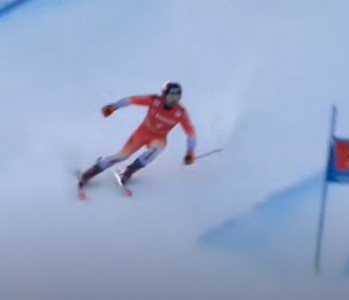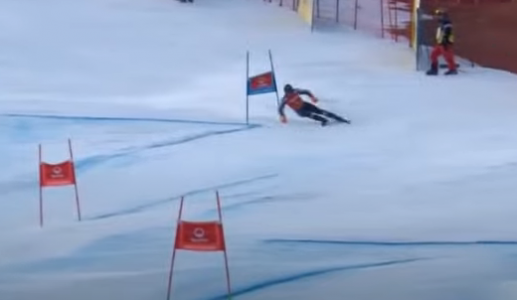#1 There is no simple way to explain or understand something very complex.
#2 If something is not making sense to you and the way you ski, it may be because you are fundamentally not at the level to learn the lesson you are trying to learn. I will comment more on this at the end. I am going to assume you ARE ready to learn the skills you are trying to learn.
#3 Stop thinking about the hips moving into the inside of the turn, falling into the turn, etc. It does not work that way. Start thinking about REACHING further out with your skis. This reach is initiated in the TRANSITION when edge pressure is light. In one of Deb Armstrong's videos she was talking to a US ski team athlete about edge angles, and he specifically mentioned "reaching" further and further out and just having supreme confident the skis would hold. Watch World Cup skiers in Slalom. Specifically look at the gates set on FLAT parts of a course, if there are any. Those gates will not be as far across the fall line. The center of mass of the skiers on those sorts of turns barely move side to side across the fall line at all. The skis are 30" out to the left...then 30" to the right, while the skiers hips are going straight down the hill. So exactly how on earth are their hips falling to the inside of the turn? They are NOT AT ALL. It is their skis that are moving, reaching, relative to the skiers center of mass. All high level race turns are like this. You want the center of mass to move AS LITTLE AS POSSIBLE, which means the skis must move out as far as possible. So again, start thinking and feeling your legs reaching, and forget about this whole toppling idea. It is just plain nonsense.
#4 If you "reach" farther out, there are two possible outcomes. A - You will end up on your inside ski and lose the outside edge, possible falling. B - you will develop higher edge angles and rip turns like an FIS skier.
#5 For most, when we "reach" really far out the former is the result because we are lacking some very challenging advanced fundamentals. Two weeks ago I took a high speed fall because I was skiing sloppy, and on a pitch too steep for my current high edge angle carving skills. I got aggressive laying into a turn. I really reached out, and the skis never had a prayer of holding. My inside ski was flatter than my outside (A-framing too much early in the turn). A flatter inside ski takes weight off the outside ski while simultaneously adding no turning force. I slid about 100 yards at 30+ mph on my hip/side. It forced me to go back to work on some fundamentals, and realize my inside ski awareness with my left leg was a big problem. This soon led to a major breakthrough for me. More on that below.
#5 The most critical advanced fundamental is inside ski awareness, and the ability to adjust BOTH your ski angles dynamically AND independently at the same time. Your inside ski is not along for a ride. In fact, for high performance high edge angle turns, your inside ski is the control system in the early, most critical part of the turn.
#6 To develop inside ski awareness and control, do Garlands, One Ski Skiing (Watch Burke Mountain Academy One Ski Drill), and then make good carved turns on a very easy/mild slope FEELING your inside ski inclination. You MUST develop the feel of dorsiflexing your inside ankle joint while driving your inside (leading) knee towards the inside of the turn (not up or forward!) to increase your inside ski edge angle. You should spend a lot of time on very easy slopes without too much pitch, just cranking turns. Build up a lot of speed, and then burn off speed as you crank high edge angle turns. You should be able to drag your inside hand without going out of position. It does not work the other way. If you can not do FIS level turns on a very flat slope, there is ZERO chance of doing them on a steeper slope. You develop the skills on easy slopes, they build the pitch while holding that form/feeling/skill set.
#7 The other advanced fundamental is the low transition. I see very very few skiers out on the hill actually do a low transition. Watch Triggerboy62's "How to CARVE LOW" to understand this better. It is one of the best explanations of the importance of the low transitions that I have found. I was at Mammoth recently, and watched some of the Jr. FIS program skiers free-skiing. Even many of them were getting lazy and not doing a consistent low transition. This is probably because it is exhausting to ski that way all the time. But this is absolutely a mandatory skill. When you are cranking a high edge angle turn, your DH/loaded leg is barely bent. Call this stacked, call it strong, whatever. It has to be in that strong position because if you bend it any more, it will collapse under the massive load. So your loaded leg is actually quite TALL in the turn, but it is inclined perpendicular for your ski bases. Skiers who rip high edge angle turns are not short....they are TALL....but they are so inclined that they LOOK low. So..... what needs to happen in transition? If you maintain this strong and tall leg position, all that energy will go into "pop" and your center of mass will bet pushed up way too much. You will push your body up. This is the old way of skiing. This un-weights everything, most importantly your skis, and makes your transition SLOW SLOW SLOW. So what you have to learn is to get SHORTER in transition. It is almost the opposite of what us older skiers learned in the 80s. In transition, your should look like you are sitting in a chair...both legs bent about 90 degrees. This is physically very hard, and technically very hard as you are in a bad position that you must very quickly recover from. But when you start to do the low transition you will be shocked at two things. #1 how quick you can go from edge to edge and #2 how it facilitates reaching further out with the skis. The whole problem with "patience" and having to wait for the skiis to initiate a carve pretty much goes out the window when you learn a low transition. You will immediately start developing edging forces. This is a big part of what makes developing early high edge angles possible.
Putting it all together, if you do not do a low transition, you really can not "reach out" to quickly create high edge angles. And if you do not have good inside ski awareness and control, creating a early high edge angle will likely just lead to a bigger crash. So, in the name of safety, learn inside ski awareness. Then learn the low transition. Then you can start to REACH more.
Now, lets take it a further level. Just recently, I learned something that I should have understood months ago. But why didn't I? I was not ready to learn the lesson. Specifically, I thought I understood how important the inside ski was. The reality was, I did not have a clue. It was not until I learned the low transition, and started really working hard on inside ski awareness that I discovered how the inside ski actually controls the outside ski edge angle. You hear lots of coaches talk about shortening the inside leg, and driving the inside knee so as to create high edge angles. But this is very misleading. I have not heard A SINGLE coach actually tell you HOW to shorten your inside leg. You are left to think that you just pull it up using your hip flexors, and then your body will just "fall" into higher edge angles. It does not work that way at all. It was not till I started developing the ability to adjust both edge angles at the same time that I had an "ah ha" moment. I have terrible inside ski feel on my left turns (I am right leg dominant) but pretty good inside ski feel on my right turns, where my inside ski is my right leg. I noticed that if I tried to incline my inside right ski (on a right turn) to a higher edge angle, then it did something strange. It basically "stretched" my inside leg/boot inside and forward and inclining my whole body AND the outside ski, while maintaining a stable balanced and highly loaded position. Total "ahha!" moment. The realization was that you do NOT "drive you knee" or "shorten your inside leg" using your leg muscles. YOU SHORTEN YOUR INSIDE LEG BY CARVING THE SKI AWAY FROM (MORE THAN) YOUR OUTSIDE SKI WHICH THEN PUSHES YOUR LEG INTO A SHORTER POSITION WITH MORE INSIDE SKI LEAD! This then cranks up your OUTSIDE SKI EDGE ANGLE. This is how the inside ski is the "control" for your outside edge angle. This is what I meant by "being ready to learn a lesson" I though I was ready to understand inside ski shortening, but I WAS NOT. My skiing was not at a level where I could understand the context of the technique. I did not have the dynamic edge control, motor control and feel to drive my inside ski to higher edge angles. I still don't with my left ski. And because I was not able to do that, my attempts to increase edge angles by shortening the inside leg just created more problems like that crash I described. I was not using the right technique to shorten my inside leg because I literally did not have the motor control to tip my ski in that way. Do slow Garlands and you will see what I mean. You may find, like me, that it is very hard to incline your non-dominant inside ski and maintain equilibrium dynamic balance. Either you fall into the hill, or the skis over edge and come under you.
So, if you are having hard time understanding certain concepts as they relate to your skiing, it may be because you are lacking some fundamentals and motor control skills that you do not even know you are lacking. This creates a tactile disconnect, and the results of some techniques may not be what you expect them to be. Pointers that people give you will not work, because you are not able to actually do the technique properly. You need to find that missing piece and fix it.


